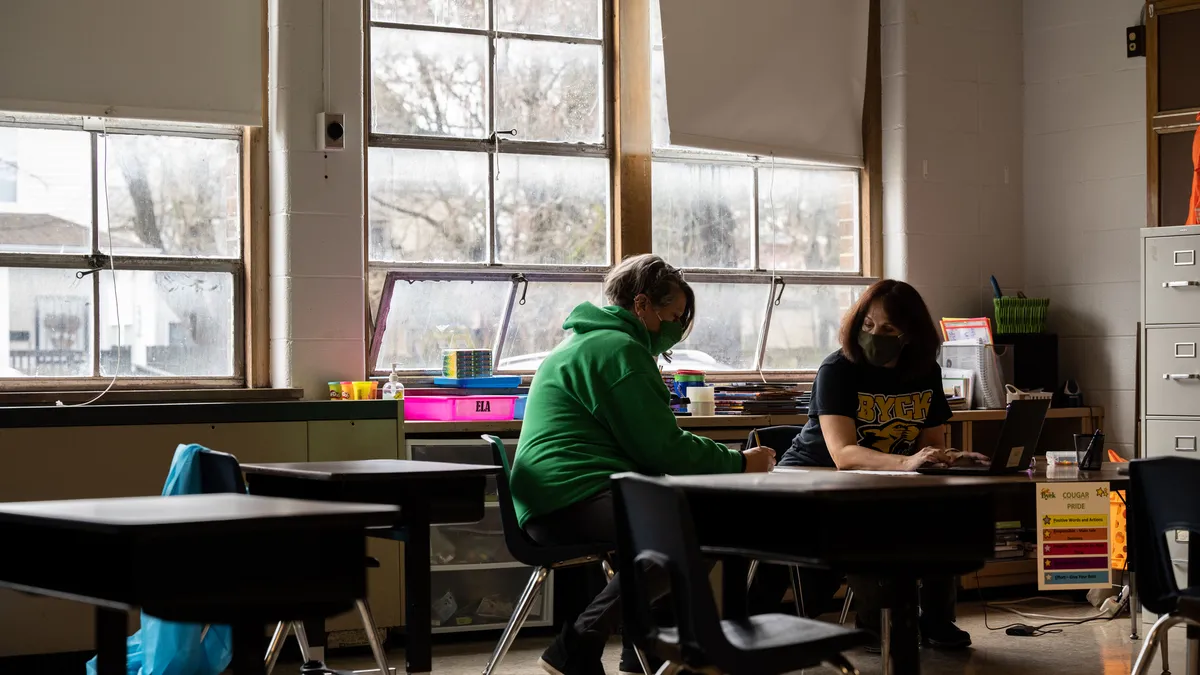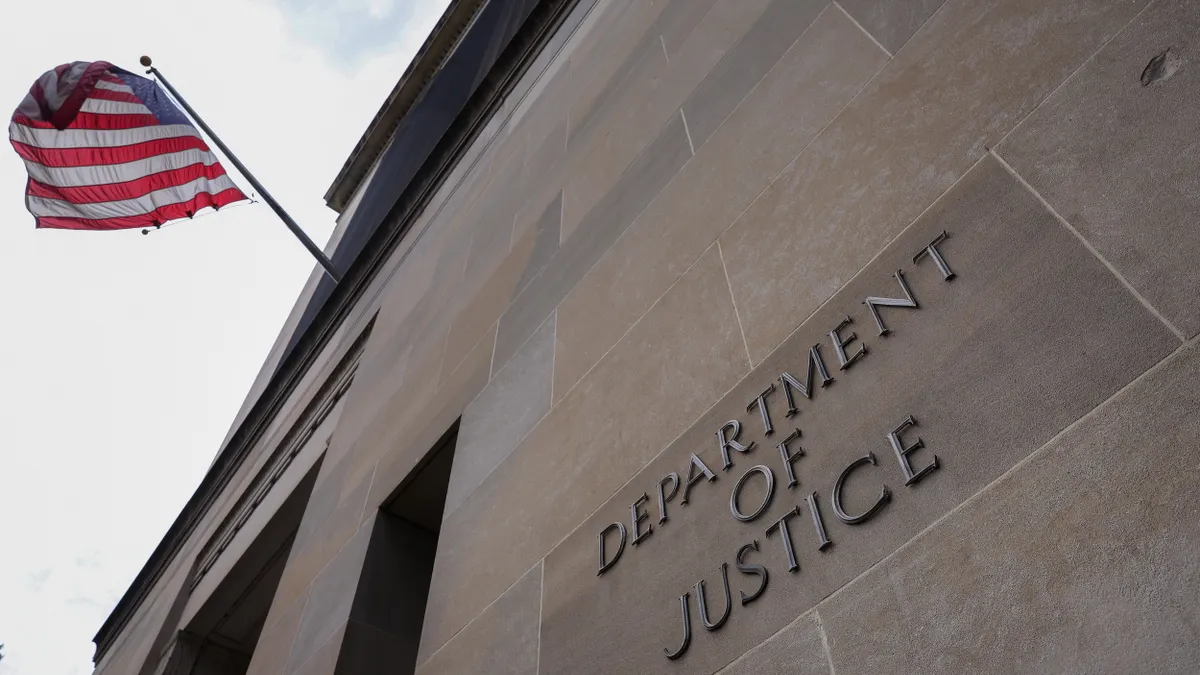For 4th grade teacher Tom Whisinnand, the most stressful part of the 2020-21 school year was simultaneously instructing his in-person and virtual learners at Reagan Elementary in Omaha, Nebraska. Technical difficulties and logistical challenges for teaching and grading were at times frustrating, he said.
For 8th grade math teacher Brandon Contreras, he was most low when he struggled to engage his virtual learners in the Compton Unified School District in California, several of whom kept their cameras off.
As educators close the books on this most unusual and trying school year, many are reflecting on what they did — or should’ve done — to manage their stress, and how they can better self-manage exacting situations going forward. School and district administrators are also acknowledging the importance of staff wellbeing and boosting SEL supports for employees.
To cope, Whisinnand took a mind over matter approach early last school year by acknowledging the difficulty of managing both “Roomers” and “Zoomers,” but also recognizing the uniqueness of teaching during a pandemic.
“I told myself it is a once-in-a-lifetime experience, and I really need to be there so that the children continue their education through this incredible, incredible time,” he said. Whisinnand also started a podcast during the pandemic with teacher Josh Monroe that highlights inspirational stories from educators across the world.
Like Whisinnard, Contreras also changed his mindset to keep himself from becoming overwhelmed. “I said, when I start being stressed out, I’m just going to remind myself to not be stressed out,” he said.
But even math teachers need a break from math. Instead of leading summer math instruction as Contreras has done for the past nine years, he’ll be teaching music and physical education this summer. “When I heard that there would be a fun aspect to summer school, I said, ‘OK, I can do that,’” he said.
The problem with teacher burnout
Teaching was already considered a stressful job before the pandemic, but research and anecdotal evidence points to a peak during the global health crisis. A survey of hundreds of teachers across the country showed varying degrees of educator anxiety around virtual instruction, communicating with parents, and balancing their school and personal responsibilities, according to research by Tim Pressley, an assistant professor of psychology at Christopher Newport University in Newport News, Virginia.
Pressley, in surveying teachers, used the Coronavirus Anxiety Scale created by Sherman Lee, an associate professor of psychology at CNU, to measure anxiety during the pandemic. Pressley’s research showed no differences in teacher anxiety based on ethnicity, location, years of teaching experience or instruction type, a CNU press release said.
Teachers who have high levels of stress and who feel burnout can be ineffective instructors, which negatively affects student achievement, said Tricia Maas, a senior research scientist at the Committee for Children.
“We know that when educators thrive, students thrive and vice-versa,” Maas said.
Many are concerned teacher burnout will lead to critical teacher shortages. According to a report from the Learning Policy Institute, a study of California school districts shows teacher shortages worsened during the pandemic. One recommendation made in the report was for district leaders to create sustainable workloads for teachers by hiring additional educators and support staff.
Another report by the RAND Corporation also emphasizes the pandemic's toll on teacher well-being and career continuation. A survey of 1,006 K-12 teachers showed nearly one in four were likely to leave their jobs after the 2020-21 school year, compared to a pre-pandemic average of one in six teachers saying they would leave the profession.
Teachers reported the top sources of stress as: engaging students; changes to their schools’ instructional models this school year; teaching remotely; making or maintaining contact with the families of their students; and supporting students’ social and emotional learning.
Maas suggests as school administrators plan schedules for the next school year, they allow teachers time during the school day to rebuild their school connections and time to collaborate with their coworkers.
“Teaching was already an incredibly isolating profession, and of course, during the pandemic, it became even more isolated and teachers were faced with this onslaught of new challenges,” she said.
Most recently, Maas has worked on the release of the Second Step SEL for Adults program, written for K-12 educators to help school communities support educator well-being. The web-based module for school staff, teachers and administrators starts by focusing on building trust with colleagues and students, as well as between students and their peers. Another module emphasizes the importance of managing stress among teachers and students. Two other modules on advancing equity and developing efficacy will be available in 2022.
“We know that when educators thrive, students thrive and vice versa.”

Tricia Maas
senior research scientist at the Committee for Children
Danielle Sullivan is a self-described former burnt-out teacher. But rather than quit the profession entirely, the national director of content and implementation for Curriculum Associates transitioned to providing professional development and support to educators who feel overwhelmed. She also offers resources to educators to improve student engagement and motivation.
Sullivan, an improv comedian, said teachers need to recognize the importance of self-care and the benefits of laughter, which can calm an anxious brain. She hopes school leaders can incorporate laughter, singing and movement into their school days to lower student and teachers’ stress levels. “Bring back the joy, because that's what we need to do in education,” Sullivan said.
'A unified effort that is focused on SEL'
In some districts, SEL approaches for students and staff go hand-in-hand.
Tomball Independent School District in Texas has implemented social and emotional supports for staff in conjunction with student interventions and resources, said Michael Webb, assistant superintendent of student support. The district’s 2,000 teachers and administrators have been trained on the signs and symptoms of mental health needs, suicide awareness, mindfulness and trauma-informed instruction, as well as a multi-tiered system of supports to provide interventions for students with a range of needs, Webb said.
An effort that began several years ago to better manage discipline through restorative justice efforts and other non-exclusionary discipline practices has helped build better school climates and provided teachers more tools to respond to student behaviors, Webb said.
The district also participates in the Emotional Backpack Project through the Center for School Behavioral Health at Mental Health America of Greater Houston. The project provides self-care tools for students, parents and educators.
“We all have experienced some degree of trauma and I think that, as a result of the pandemic, I think we are more flexible to individual circumstances, for more understanding of mental health needs of students, in our co-workers and of the community,” Webb said.
In the Metropolitan School District of Wayne Township in Indianapolis, Indiana, teachers were trained to recognize their own social and emotional well-being while undergoing professional development in the Committee for Children's Second Step SEL curriculum for students, which the district started during the 2018-19 school year, said Alicia Erwin, assistant principal of Rhoades Elementary.
“We knew that in order for it to be impactful for our students, we had to embody it as a staff, and we had to learn that these skills have to be taught and practiced and reinforced and encouraged,” Erwin said.
The school district emphasizes wellness for students, families and staff in six different domains and support structures: social, emotional, behavioral, physical, financial and nutritional. For example, the district has two SEL coaches who will work only with school staff next school year to build staff capacity and understanding so the adults can model SEL skills and build them into the curriculum, said Tara Rinehart, the district’s director of special services.
The district also has a nutritional coach and financial expert available for its 2,500 staff members who seek advice in those areas, Rinehart said.
As the district continues with this work, it is also focusing on equity and how people from various cultures or backgrounds may need different types of mental health resources and supports. That work is being supported by the districts’ Mental Health and Wellness Committee, which includes a variety of stakeholders, as well as the district’s new diversity, equity and inclusion officer, Erwin said.
“We're really a unified effort that is focused on SEL, that's focused on equity, that is focused on building capacity in an inclusive way for our families, our community members, and our students and staff,” Erwin said.







 Dive Awards
Dive Awards













